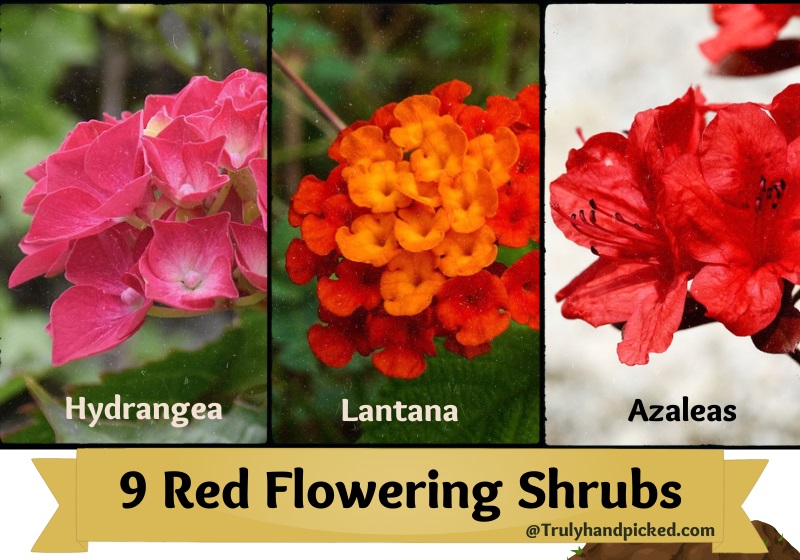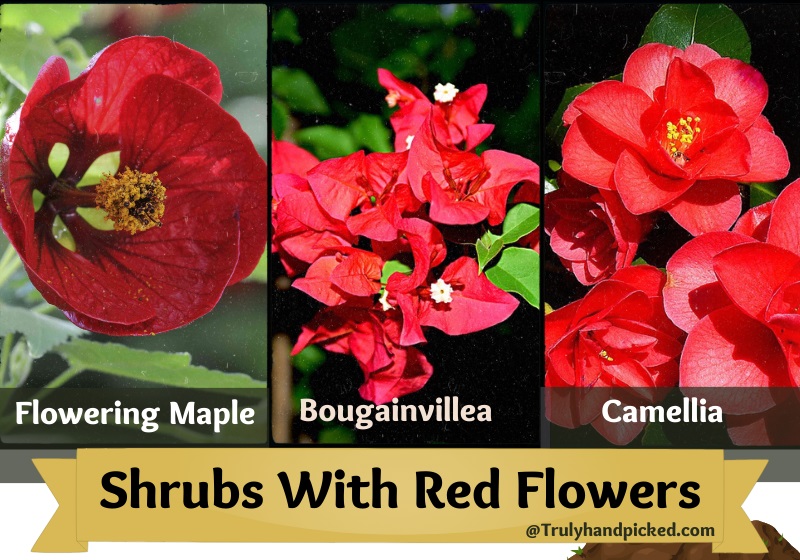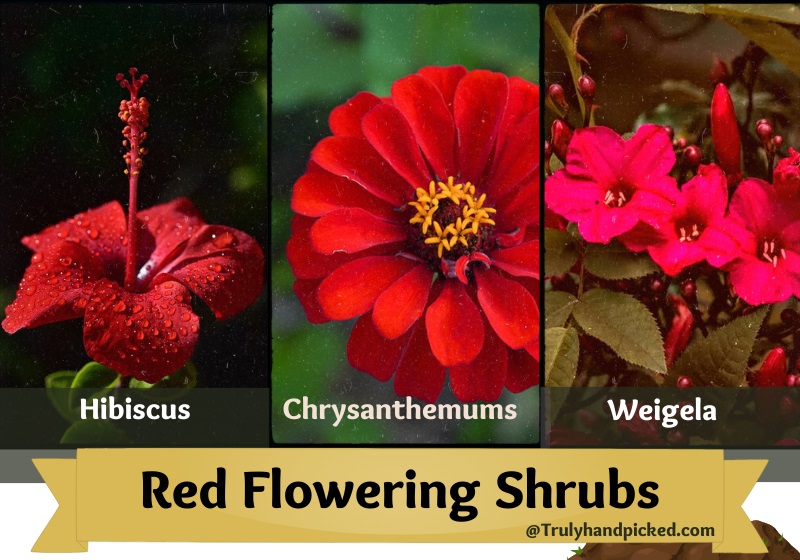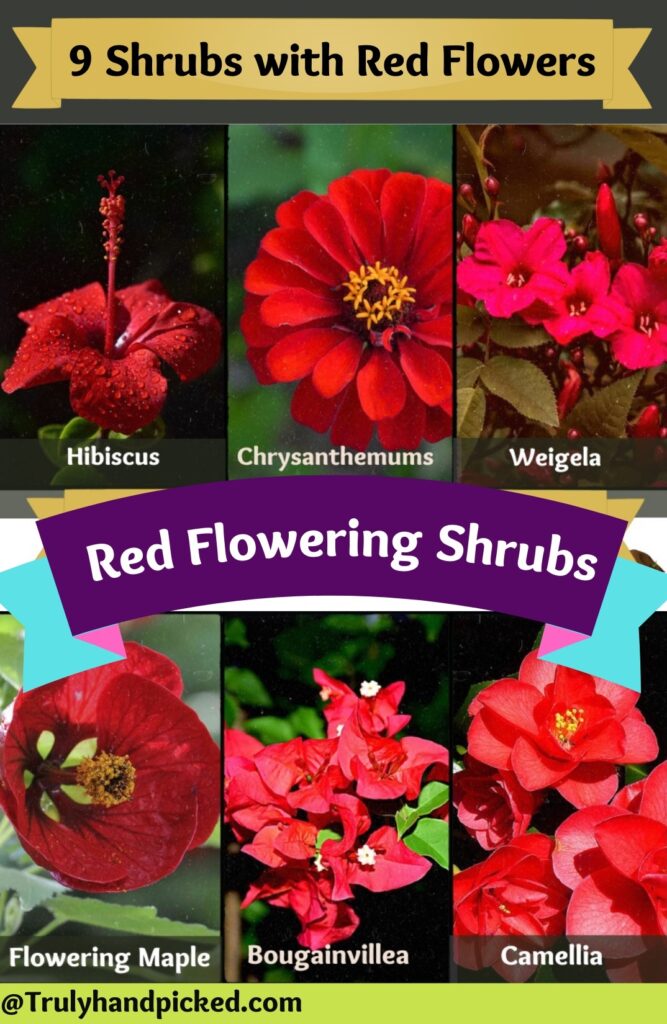Who doesn’t want to revamp the glance of their garden with some vibrant blossoms? Well, growing some shrubs with vibrant red flowers would be a great idea for such attempts.
Plants with Red Flowers. 1 Hydrangea 2 Lantana 3 Azaleas 4 Flowering Maple 5 Bougainvillea 6 Camellia 7 Hibiscus 8 Weigela 9 Chrysanthemum.
Scroll down for detailed plant care basics and quick tips for red flowers around the year.
Red is an eye-catchy shade and, flowers in this hue look more attractive when blooming over the deep green surface of shrubs.
You must pick some easy-to-grow species from this category while trying to cultivate them in your yard. Here are 9 best options we pick for you, which can grow easily as beautiful houseplants in your outdoor garden area-
9 Beautiful Plants with Brilliant Red Flowers
Red Hydrangea:
About the Plant:
The red hydrangea shrub is a great choice to plant in your garden if you want to make the garden look more dynamic. This plant grows vibrant red flowers over its green bush and mostly blooms during the Summer.
To make your hydrangea look deep red, you can add dolomite lime to make your soil more alkaline. This process can bring deep brilliant red flowers from your hydrangea to your summer garden.
Note: Hydrangea prefers the morning sun and shade in hot afternoons. So avoid placing it in a spot where the afternoon sun directly scorches your hydrangea
Soil Mix: Red hydrangea thrives best in loose alkaline type soil that is well-drained but can retain moisture for a long.
Fertilizer: Use natural fertilizer with organic matter and use fertilizer in a 10-10-10 ratio to grow this plant in your garden
Climate: It grows best with indirect sunlight with partial shade and in the hardiness of 4-9 zones.
Water: This plant needs a lot of water at its initial stage of growth. Try to water the hydrangea plant 3 times a week.
You may also be interested in plants with red leaves for your garden.
Red Lantana Shrub (Dallas Red):
About the Plant:
This plant can grow indoors as well but thrives in the bush form while cultivating in your outdoor garden. Lantana shrubs can grow long almost 6 feet when they plant in a garden bed directly. Most of the lantana shrub plants breed orange blossoms but, some species produce red flowers too.
You can expect brilliant bright red with orange and yellow hue flowers from this lantana species. Lantana flowers are another cool way to attract butterflies, bees, and hummingbirds to your garden. These red flowers are very tempting for little pollinators.
Though red lantana can thrive in shades, it reduces your plant’s flowers and is prone to pests. Providing full sun for the whole day will fetch lovely red flowers and a healthy plant.
Soil Mix: Lantana likes rich and well-drained soil types that must be a bit acidic.
Fertilizer: Pick a general nitrogen-based balanced fertilizer with good quality in the ratio of 20-20-20. and give diluted strength in being.
Sunlight Requirements: This beautiful flowering plant claims full sun with direct sunlight to thrive. Lantana can stand in warmer zones starting from zone 8.
Water: Water your newly-planted lantana pant regularly and fulfill the mark of 1-inch watering every week to give your plant the best growth.
Red Azaleas:
About the Plant:
Azalea is a perennial plant, whose shrub can produce different vibrant colored blossoms including red ones. Despite bringing a bushy plant, you can grow azaleas either in a planter or in your indoor garden.
The red flowers of this plant have a mild fragrance thus, inviting butterflies and hummingbirds to your yard. Your red Azaleas will grow as a compact shrub with more flowers in full sun and as a lengthy growing plant with lesser yet long-staying flowers in partial shade.
Varieties of Red Azaleas: Autumn bonfire, darkness, ruby, embers, and autumn bravo
Soil: This plant prefers well-drained acidic soil that can hold moisture for a while. Keep the pH level 5.0-5.5.
Fertilizer: Pick a fertilizer rich in nitrogen, potassium, and phosphorus equally with a 15-15-15 ratio.
Sunlight: Azalea plant thrives best in zone 5 or above, try to provide your plant with full sunlight to partial shade.
Water: This plant doesn’t require much watering, but try to give at least ¾ inch of water for every 10 days to provide the best growth to your plant. Do mulching on top to prevent roots from drying out faster.
Related: Plants with orange flowers
Abutilon – Lucky Red Lantern (Flowering Maple):
About the Plant:
Flowering maple can make your garden look like a heavenly place with its scarlet blossoms. The shrub can grow 8 feet long, so, you should plant this flowering genus of maple in your outdoor garden area. With the perfect growing climate, you can cultivate this beautiful shrub although the year.
Abutilon is hardy in zone 9-11 and likes the full sun with light shade in the afternoon (prevents wilting and burning leaves in hot zones).
And yes this red flowering maple can be grown in pots, it adapts to the containers and needs 6-8 hours of sunlight to bloom better and remain healthy. If you want it indoors go for a south-facing window that caters to its sunlight needs.
Soil: Abutilon requires moist, rich, well-drained, and acidic soil with a pH of 5.0 to 7.0.
Fertilizer: Use water-soluble fertilizer to grow such maple species in your yard with an NPK ratio of 18-18-18.
Climate: Flowering maple plant needs bright sunlight and can stand direct to a partial shade climate with zones of 9-10.
Water: Outdoor maple plant claims moderate watering to thrive the best. Try to water your plant when ½ inch of the top surface of the soil turns completely dry.
Do you love big leaves, then check out some houseplants with big leaves.
Bougainvillea with Red Flowers (Bracts):
Varieties: Barbara Karst & Sandiego red
About the Plant: Bougainvillea is a smart choice to grow in an open outdoor garden area for its catchy blossoms over thriving shrubs.
This plant can grow 3-4 bright-colored flowers including red types. This is one of the bushiest red flowering plants around that can turn a huge shrub if you don’t prune the plant in time.
Bougainvillea gives brilliant bright red flowers throughout the warm season and its hardy shrub grows long and remains evergreen. Pruning it compact will promote new growth which gives a lovely red bushy ball-like structure.
Soil:
Bougainvillea likes loamy rich soil that can drain water quickly.
Fertilizer:
Use a balanced fertilizer with the perfect proportion of nitrogen, phosphorus, and potassium with a ratio of 5-5-5.
Climate:
This plant can stand in full sun with direct sunlight. Maintain the climate in between 9-11 zones for the best growing result.
Water:
Bougainvillea doesn’t need much water to thrive. Try deep watering after every 3-4 weeks, only if the leaves or stems seem to gasp.
Want some super-performing indoor plants, check out these best low-light indoor houseplants.
Red Camellia:
About the Plant:
Camellia is a must-have flowering shrub to grow in your garden that can beautify the whole look of your yard solitarily.
This plant has two types japonica and sasanqua, which bloom in different seasons. Both species produce catchy red flowers with puffy petals.
Best Red flowering Camelia Varieties: Satsuma Kurenai, Japonia black magic, Royal velvet, October magic ruby, and Yuletide.
Soil:
Camellia needs an ericaceous soil type with little mulching to retain water for a long while. Choose soil with well-drained quality and keep the pH level between 5.5-6.0
Fertilizer:
Go with organic fertilizers like rotted manure to give the camellia plant the most exciting thrive. Pick a slow-release fertilizer with an 8-8-8 ratio, as this plant doesn’t need much fertilization to grow.
Climate:
Both species of camellia can grow best in semi-shade or dappled-shade spots in your garden. Maintain the hardy zone between 6-7 for the best growth of your red flowering shrub.
Water:
In the beginning, you should water camellia shrubs once a week 2-3 inches deep down into the planting soil. Then, reduce it to once every 2-3 weeks.
Related: Plants with white flowers
Red Flowering Hibiscus:
About the Plant:
Hibiscus or rose mallow is a wonderful plant to grow in your garden. Flowers of this plant have auspicious value in Hindu culture.
Hibiscus plants can produce various types of flowers including red, but red hibiscus is the most common category of their species. This tropical plant can grow long with sturdy stems with proper care and bloom all year long.
Soil:
Hibiscus grows best in loamy or sandy soil, which releases water quickly. Choose slightly acidic soil with a pH between 6.5-6.8.
Fertilizer:
Use compost rich in potassium content and pick slow-release liquid fertilizer to give your hibiscus plant the best growth.
Climate:
A hibiscus plant can stand full sunlight. So, you can easily grow this plant in your outdoor garden by maintaining a temperature of 60-90 degrees F. It can survive in different zones starting from 4 to 12.
Water:
During the summer season, the hibiscus plant needs lots of watering. Water your plant regularly in a hot climate but water infrequently once the winter comes.
Related: Plants with yellow flowers
Red Chrysanthemums:
About the Plant:
Chrysanthemums or mums are a brilliant type of shrub to grow in your outdoor garden that produces an abundance of red flowers during its blooming time. This plant can grow longer than 3 feet but gets wider unusually with lots of bushes.
Soil:
Well-drained sandy or loamy soil is the best choice to grow chrysanthemums in your yard. Keep the pH balance between 6.5 to 7.0.
Fertilizer:
Pick a fertilizer that is balanced with nitrogen, phosphorus, and potassium with a ratio of 5-4-1 to let the plant best thrive.
Climate:
Chrysanthemums grow in both tropical and subtropical climates, so you can provide full to the partial-shade sun to boost the growth of your bushy plant. This plant can stand the hardy zones 5 to 9 all through the year.
Water:
Water your chrysanthemum plant in the morning intensely around 6-8 in deep in the garden bed for the best outcome of your cultivation.
Related: Plants with red leaves
Pinterest Image
Weigela:
About the Plant:
Weigela is an unusual flowering plant to grow in an outdoor garden area. This plant produces yellow pink and white flowers too, besides the red ones. This perennial shrub can reach 6-8 feet long with a real bushy texture. You must prune your outdoor weigela plant in time to keep the bushes manageable and remain attractive to peek at.
Soil:
Weigela likes slightly alkaline to acidic soil types that can drain water easily. Keep the pH level between 5.5-7.5.
Fertilizer:
Fertilize this easy-to-grow shrub with NPK-balanced fertilizer with a 10-10-10 ratio and try to feed the plant after every six weeks.
Climate:
Weigela can grow in full to partial-shade sunspots with a hardy zone of 4 to 8. Try to maintain the temperature between 25 to 30 degrees F for this plant especially, during its blooming time.
Water: Water your garden weigela plant moderately and after every 10-day gap to get it in the best thriving form.
Want to lure bees to your place, learn about the best flowering plants to attract bees to your garden.




